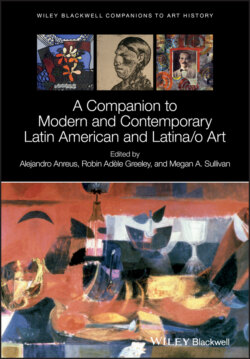Читать книгу A Companion to Modern and Contemporary Latin American and Latina/o Art - Группа авторов - Страница 48
5 Photography, Avant‐Garde, and Modernity
ОглавлениеEsther Gabara
*
* *
Photography seems, at first glance, to enjoy an obvious and straightforward affinity with dominant visions of modernity. What could be more modern than replacing a handmade oil painting, the labor of an artist with years of academic training, with a machine‐made snapshot that anyone can quickly learn to make? It seems logical that photography, more than any medium, ought to present modernism and modernity hand in hand. But although it is certainly impossible to take a photograph of a modern technology before its invention – we could not take a picture of a typewriter before it existed – this logic is not reversible. The invention of a new technology does not guarantee its conversion into an icon of modernity or its contribution to the aesthetic language of modernism.1 Certain tropes, those rhetorical figures that stand for the modern at large, have become so familiar as to be almost invisible today, whereas others never entered those lexicons. In what follows, I show how, despite its status as the proclaimed peripheries of modernity, Latin America makes the contours of these figures of modernity visible once more, reveals hidden tensions and contradictions within, and so makes possible a critical reexamination of the politics, ethics, and aesthetics of global modernity.
Neither copies of European avant‐gardes of the 1920s and 1930s nor isolated and authentic reservoirs of racial difference, the Latin American avant‐gardes reveal the logic behind global modernity and demand that we expand the horizon of possibility for modernist aesthetics. Photography embodied key tropes of modernity in the Latin American movements as well as in canonical European essays by Walter Benjamin, Siegfried Kracauer, and Roland Barthes. The camera pictures and is pictured as tropical and savage, as feminine and mass‐produced. Although scholars have identified the deep uncertainties these tropes reveal in mainstream avant‐garde theory, they have not explained why or how such a fraught medium came to play such an important role in the historical and more contemporary avant‐gardes. Ultimately, what seem at first to be peripheral exceptions to the dominant rules governing modernism, modernity, and the avant‐garde offer not a better definition of the three, but a mode of thinking through them. The varied uses of photography and the position of Latin American avant‐gardes make visible another theory of modernity articulated from the other side of the modern‐colonial divide that separates Europe from its former colonies.2 They teach us not to think about avant‐garde and modernism “in the context” of modernity but as what I have introduced elsewhere as “errant” interventions in its discursive formation.3 The paths by which modernity “expands,” as it is typically told from the West, were not paved only by Europeans and North Americans but were precisely the themes and practices of Latin American avant‐gardes. In this map, modernity is not the destruction of difference as a result of a global homogenization, nor a phenomenon that occurs only in economic centers, but rather must be defined as the tension that produces a series of critical interventions, histories, and aesthetics. That is to say, Latin America disorients the hegemonic histories and theories of photography that still overwhelmingly privilege European and US artists, and in doing so, offers a view onto the power, promise, and dangers of the global phenomena of modernism, avant‐garde, and modernity.
